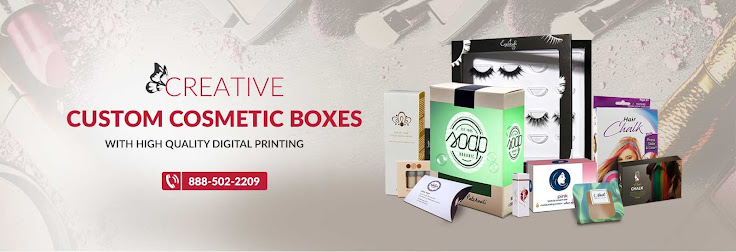The Ultimate Guide to Custom Beauty Product Packaging: Boosting Brand Identity and Sustainability
In the fiercely competitive beauty industry, product packaging shapes a brand's identity and attracts consumers. Custom packaging has emerged as a critical strategy for beauty brands to distinguish themselves and leave a lasting impression.
Custom Beauty Product Packaging involves creating
unique solutions tailored to a beauty brand's needs. These solutions encompass
materials, design, colour, typography, and functionality. Essential elements
include brand identity, consumer appeal, functionality, and sustainability. These
components work together to produce attractive packaging that effectively
protects and presents the product.
Custom packaging is vital for branding. It allows companies
to express their unique identity and values, making their products instantly
recognizable. Attractive and distinctive packaging can attract consumers and
encourage them to choose one product over another. Additionally, well-designed
packaging enhances the user experience, increasing customer loyalty and repeat
purchases. With growing environmental consciousness, sustainable packaging
options are becoming more popular. Custom packaging can incorporate
eco-friendly materials and designs, appealing to the environmentally conscious
market segment.
Current Custom Beauty Product Packaging trends
include minimalistic designs with clean lines and simple graphics, conveying
elegance and sophistication. Eco-friendly materials like recycled paper,
biodegradable plastics, and plant-based inks are becoming standard, reflecting
a commitment to sustainability. Personalized packaging, where consumers can add
their names or choose specific designs, enhances the customer experience and
fosters a deeper connection with the brand.
To design Custom Beauty Product Packaging
effectively, it is essential to understand your brand's identity and values.
Knowing your target audience is also crucial, as the packaging should appeal to
their tastes and preferences. Material selection is critical for aesthetics and
functionality, considering the product's needs, brand values, and environmental
impact.
Colours significantly impact consumer behaviour, and
understanding colour psychology can help choose the right palette that evokes
the desired emotions. Effective use of graphics, including logos, images, and
other visual elements, enhances the visual appeal and aligns with the brand's
identity. Typography affects readability and brand perception. Choosing fonts
that align with your brand's personality is crucial, considering legibility,
style, and how the typography complements other design elements.
Innovative packaging solutions, such as intelligent
packaging technology like QR codes or NFC tags, provide consumers with
additional information or interactive experiences through their smartphones.
Interactive and augmented reality packaging offers immersive experiences,
allowing consumers to engage with the product in new and exciting ways.
Custom packaging can be more expensive than standard
options, so balancing the costs with the benefits is essential to ensure they
add value to your product. Production capabilities can limit design and
material choices, but working with experienced packaging partners can help
navigate these challenges.
Brands like Glossier and Fenty Beauty have leveraged custom
packaging to establish a strong brand presence. Analyzing their strategies
reveals best practices and innovative approaches that can inspire your
packaging solutions. Sustainability is not just a trend but a necessity.
Eco-friendly packaging reduces environmental impact and meets consumer demand
for greener products. Examples include packaging made from recycled materials,
compostable packaging, and designs that minimize waste.
Compliance with packaging regulations ensures that your
products can be sold legally and meet industry standards. Accurate labelling,
including ingredient lists, usage instructions, and required warning labels, is
essential for consumer safety and transparency.
Emerging trends in Custom Beauty Product Packaging
include using AI in design, increased focus on personalization, and more
sustainable packaging solutions. The future of packaging will likely see
further integration of technology, increased sustainability efforts, and more
innovative design solutions that enhance the consumer experience.
Getting started with custom packaging involves choosing a
packaging partner with experience in the beauty industry to make the process
smoother and more efficient. A step-by-step guide to creating custom packaging
includes:
- Defining
your brand identity and goals.
- Researching
and choosing materials.
- Working
on the design, prototyping and testing of the packaging.
- Finalizing
and producing the packaging.
In conclusion, Custom Beauty Product Packaging goes
beyond aesthetics. It enhances brand identity, attracts consumers, and promotes
sustainability. By understanding the key elements, benefits, and trends, brands
can create packaging that adds significant value to their products.



Custom packaging is vital for branding.
ReplyDeleteThis is an incredibly insightful article on the importance of custom beauty product packaging. I appreciate how it covers not just the aesthetic aspects but also the functional and sustainable elements. It's fascinating to see how packaging can play such a significant role in brand identity and consumer engagement. The examples of brands like Glossier and Fenty Beauty are particularly inspiring, showcasing how innovative and eco-friendly packaging can set a brand apart. Thank you for sharing these valuable insights and trends—definitely some food for thought for anyone in the beauty industry!
ReplyDelete